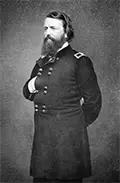Civil War General John Pope
John Pope was a general in the Union Army during the American Civil War. He had successes in the West in the early part of the war but is most well-known for his defeat the Second Battle of Bull Run/Manassas in 1862. 
He was born on March 16, 1822, in Louisville, Ky. He chose a life in the military and graduated from West Point in 1842. His commission was a brevet second lieutenant in the Corps of Engineers. Pope's early surveying work was in Florida and in the northeastern U.S., where he surveyed the border with Canada. He later worked in Minnesota and as chief engineer of the Department of New Mexico; his final surveying duties included surveying a route for the Pacific Railroad. He first saw combat during the Mexican-American War, serving under Zachary Taylor at the Battle of Monterrey and the Battle of Buena Vista. After escorting President-elect Abraham Lincoln to Washington, D.C., he gained appointment as brigadier general of volunteers and sent to Illinois. Pope commanded the District of North and Central Missouri. He clashed with his superior officer, Maj. Gen. John C. Frémont, but found success in the field when he took 1,200 prisoners at Blackwater, Mo., in December 1861. Frémont's replacement as head of the Department of the West, Henry Halleck, named Pope commander of the Army of the Mississippi in February 1862. Pope responded with a pair of successes, taking New Madrid, Mo., in March and the capturing the strongly fortified Island No. 10 in April; as a result, Union troops could travel down the Mississippi River as far as Memphis. For these actions, he was promoted to major general. He commanded a company of troops during Halleck's taking of Corinth, Miss., in May 1862, then gained appointment as commander of the newly formed Army of Virginia. Pope had a high opinion of himself and his abilities and had some successes to his name by the time he arrived in Virginia to take command of the troops there. However, he quickly offended them by disparaging their accomplishments so far in the war. Pope was an aggressive tactician, as proved by his innovative deployment of troops in capturing Island No. 10. However, he proved indecisive at crucial moments in commanding his new Virginia army and found himself out west again after a handful of months. The Army of Virginia numbered 70,000 men when Pope was in full command. The Army of Northern Virginia, then commanded by Robert E. Lee, numbered 55,000. Lee sent Maj. Gen. Stonewall Jackson and 24,000 men to Cedar Mountain as a diversion; the result was a Jackson victory over Nathaniel Banks. Jackson then quickly captured Pope's main base of supply at Manassas and forced another battle near that town, in which Pope proved unequal to the challenge of fighting Lee, Jackson, and Maj. Gen. James Longstreet. The Aug. 28–30 battle was a resounding Confederate victory. Pope was relieved of his command on September 21, and his army became part of Gen. George McClellan's Army of the Potomac. Pope's new appointment was in Minnesota, as commander of the Department of the Northwest, during which time he oversaw action against Native Americans, in the Dakota War and later in the Apache Wars. He was governor of the Reconstruction Third Military District, in April–December 1867, and had headquarters in Atlanta. One of his orders was to allow African-Americans to serve on juries. Other appointments in the West included a stint as commander of the Department of the Lakes in 1868–1870 and as commander of the Department of the Missouri in 1870–1883. His final command was of the Military Division of the Pacific, from 1883 to his retirement in 1886. He had been promoted to major general in 1882. From 1887 to 1891, the National Tribune printed his memoirs in serial form. He died on Sept. 23, 1892, near Sandusky, Ohio. He was 70. |
|
Social Studies for Kids
copyright 2002–2024
David White




